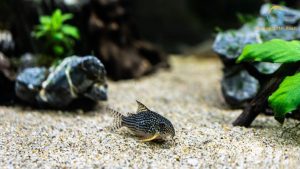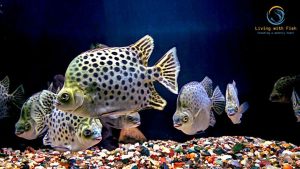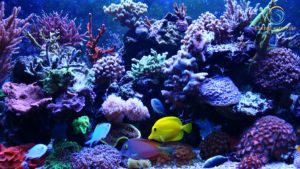This article covers the following areas –
- Benefits of Small Fish in Nano Tanks
- Little Fish, Big Impact: The Perfect Companions for Your Nano Tank
- How to Take Care of Your Tiny Fish
- In Conclusion

There’s something incredibly mesmerizing about nano tanks. These pint-sized aquariums, often no larger than 10 gallons, have found a special place in my heart. Their compact size allows for creativity in tight spaces, making them perfect for a desktop or a small apartment corner. But what truly makes a nano tank shine? The tiny, vibrant fish that call it home. Let’s dive in and discover some of the best small fish for these little aquatic wonders.
Nano tanks, typically small aquariums under 10 gallons, are ideal for housing diminutive fish species. Popular choices include Celestial Pearl Danios, Endler’s Livebearers, Chili Rasboras, and Pygmy Corydoras. These fish thrive in compact environments when provided proper care.
For enthusiasts eager to delve deeper, the following sections offer a comprehensive guide on the best small fish for nano tanks. Learn about their unique behaviors, care requirements, and tips to create a thriving mini-aquatic ecosystem. Let’s embark on this nano journey together.
Benefits of Small Fish in Nano Tanks
Whenever I chat with fellow aquarium enthusiasts or scroll through aquascaping forums, I’ve noticed a consistent trend: the rising popularity of nano tanks and their teeny-tiny inhabitants. Now, while these mini aquariums are undeniably cute, there’s more to their appeal than just their compact size.
The small fish thriving in these tight quarters offer many benefits that novice and seasoned aquarists can appreciate. From the ease of maintenance to the delightful array of species you can house, there are many reasons to opt for small fish in nano tanks.
Easy Maintenance
One of the primary reasons I’ve gravitated towards small fish for my nano tanks is the surprisingly straightforward upkeep. Their diminutive size means that they produce less waste. Why is this a big deal, you ask?
- Waste Management: Lower waste production translates to fewer water impurities. This means you won’t be battling high nitrate or ammonia levels as often, ensuring your water quality remains top-notch with minimal fuss.
- Less Frequent Cleanups: While I don’t advocate neglecting your tank, I’ve observed that tanks with smaller fish don’t get dirty as quickly. The result? Fewer cleaning sessions and more time to enjoy your aquatic setup.
Greater Variety
Size matters, especially regarding the variety of fish you can introduce into a nano tank. I’ve always been amazed at the range of small fish species available.
- More Species, Same Space: With small fish, you can have a mixed community of various species in the same tank without them feeling cramped. It’s like having a mini-ocean right in your living room!
- Aesthetic Appeal: There’s a special charm in watching different species with varying colors, patterns, and behaviors coexist. It turns your tank into a dynamic, ever-changing canvas.
Affordability
Let’s be honest; hobby expenses can add up. However, I’ve found a silver lining with small fish.
- Budget-Friendly: Most small fish species are relatively inexpensive. You can often purchase a group without breaking the bank.
- Low Operational Costs: Their diet requires less food, and with fewer waste issues, you won’t be spending as much on water treatments or larger filtration systems.
Space Efficiency
Space is a luxury, especially for apartments or smaller homes. But with small fish in nano tanks, you can still indulge in your aquatic passion.
- Perfect for Any Corner: These tanks can fit almost anywhere – on a work desk, a bedside table, or a small shelf. It’s a slice of nature that doesn’t demand vast space.
- Easy Relocation: Should the need arise, moving your tank to a different spot is less cumbersome than lugging around a massive aquarium.
In essence, small fish in nano tanks are a match made in aquatic heaven. They offer a larger setup’s beauty and tranquility but have fewer responsibilities and demands. It’s no wonder they’re gaining popularity in the aquatic world!
Little Fish, Big Impact: The Perfect Companions for Your Nano Tank

So, you’ve decided to dive into the captivating world of nano tanks. Excellent choice! But a tank, no matter how elegantly set up, is incomplete without its vibrant inhabitants. Choosing the right fish for these smaller aquariums can be a delightful yet daunting task, given the many options available.
From my personal journey, I’ve discovered that the magic lies in their size and the unique characteristics each species brings. Whether you’re after bright colors, mesmerizing patterns, or endearing behaviors, a tiny finned friend is waiting to dazzle your nano setup. Let’s embark on this underwater adventure and meet some of the pint-sized superstars that have brought joy to my tiny aquatic worlds.
1. Celestial Pearl Danio
The first time I encountered Celestial Pearl Danios, I was spellbound. Their vivid, intricate patterns evoke images of a starry night sky. Not only are they a sight to behold, but their behavior is equally fascinating.
These little wonders are native to small ponds in Myanmar, which might explain their preference for calm waters. If you want to replicate a slice of their natural habitat, I recommend adding fine-leaved plants and a soft substrate. This mimics their natural surroundings and gives them plenty of hiding spots, ensuring they feel safe and secure.
Another aspect is their peaceful temperament, making them ideal for community nano tanks. However, while they’re relatively easy to care for, it’s essential to maintain stable water conditions to keep them thriving.
2. Endler’s Livebearer
Ah, the Endler’s Livebearers! While their resemblance to guppies often leads to confusion, any seasoned aquarist can vouch for their distinct personality and appearance. Originating from the freshwater streams of Venezuela, these fish have adapted beautifully to aquarium life.
What’s captivating about them is their resilience. They’re hardy fish, making them great for beginners. But don’t be fooled by their small size; they have a penchant for breeding. If you’re not looking for a booming population, I’d advise keeping an eye on their male-to-female ratio.
One delight of having Endlers in your tank is observing the courtship dance of the males as they try to woo their female counterparts. Their lively nature and stunning color variations make them a dynamic addition to any nano tank.
3. Chili Rasbora
Native to the blackwater streams of Borneo, the Chili Rasboras have become a sensation in the nano fish community. Their fiery hue is reminiscent of chili peppers, giving them their unique name.
But their color isn’t the only vibrant thing about them; they have a spirited nature to match. Despite their vivaciousness, they’re naturally peaceful, making them perfect tankmates for other non-aggressive species.
A dimly lit tank with many plants would be ideal for those looking to breed them. It replicates their natural environment and provides the females a safe place to lay eggs. One thing to remember is that they can be sensitive to water parameter changes. Regular monitoring and maintenance can ensure these little flames continue to light up your aquarium.
4. Pygmy Corydoras
One of the more endearing traits of the Pygmy Corydoras is their school-oriented behavior. Often, I’ve found them congregating with their kind, moving together in harmony as if choreographed. Originating from Brazil’s Madeira River tributaries, they’re adapted to softer waters.
So, if you’re considering introducing them to your nano tank, it’s a good idea to use driftwood and leaves to replicate their native environment. Their armored plates give them a prehistoric look, adding another intriguing layer. A fascinating tidbit? They can breathe atmospheric air! Every once in a while, you might spot them darting to the surface for a quick gulp.
While they’re predominantly bottom dwellers, this characteristic behavior ensures they’re never out of sight for too long.
5. Sparkling Gourami
Sparkling Gouramis have always held a special place in my heart with their intricate patterns and gentle bubble-like croaking sounds. Native to the acidic waters of Thailand, Cambodia, and Vietnam, they thrive in softer water conditions.
The bubbling sound, often mistaken for a malfunctioning filter, is their unique way of communicating, especially during the breeding season. Labyrinth fish can breathe directly from the air, making occasional trips to the surface.
One of the things I love about them is their curiosity. Drop in a new plant or decor, and you’ll find them inspecting it with keen interest. If you’re planning on breeding, remember they’re bubble nest builders. Providing floating plants can give males the perfect platform to showcase their nesting skills.
6. Scarlet Badis
The very essence of “small but mighty,” the Scarlet Badis is a testament to nature’s artistry. Hailing from the waters of India, they prefer dense vegetation, replicating their native submerged terrains.
Their chameleon-like ability isn’t just about camouflage; it’s a window into their emotions. A well-fed and content Scarlet Badis will flaunt more vibrant colors, whereas stress or ill-health might cause them to dull down. They’re territorial, especially the males, so providing ample hideouts can prevent skirmishes.
Though they’re carnivorous, feeding them can be an adventure. I’ve often found it entertaining to introduce live foods and watch their hunting instincts come alive.
7. Boraras Brigittae
The Boraras Brigittae, with its bold hues, is like a drop of fiery ruby in the calm waters of a nano tank. Native to the swamps and streams of Southwestern Borneo, they prefer slightly acidic waters. The dark substrate can intensify their colors, making them pop even more.
Being small and peaceful, they’re best kept in schools where their synchronized swimming creates a mesmerizing display. Their size, however, makes them susceptible to predation. So, if they’re sharing a tank, ensure it’s with equally peaceful and non-aggressive tankmates.
On the feeding front, their tiny mouths mean that finely crushed flake food or micro-pellets work best, though they have a particular fondness for live foods like daphnia or brine shrimp.
8. Green Neon Tetra
Originating from the clear water streams of South America, the Green Neon Tetra offers a mesmerizing display of iridescent green that beautifully complements their transparent bodies.
Watching a school of them swim synchronously amidst the green of live plants is reminiscent of a magical forest scene. What I particularly love about them is how their colors seem to change based on the lighting and backdrop of the tank. Unlike their neon counterparts, they’re a bit more sensitive to water parameters, so ensuring clean, stable conditions is key.
Additionally, their small size and peaceful nature mean they’re perfect for a community setup, though it’s essential to avoid larger or aggressive tankmates who might see them as a snack.
9. Pea Puffer
The Pea Puffer, native to freshwater habitats in India, always reminds me of an inquisitive child with their constant exploration and big, round eyes. Their yellow-green coloration and dark spots give them a unique appearance that stands out in any setting.
While they’re primarily carnivorous, relying on snails, worms, and other small invertebrates, their hunting habits provide a fascinating display of natural behavior. But keep them in a tank with ample hiding spaces and plants, as they can occasionally be territorial.
Their size can be deceiving; they’re packed with personality and often exhibit behaviors that make it seem like they’re interacting with their owners.
10. Betta Fish
Bettas, also known as Siamese fighting fish, hail from the shallow rice paddies of Thailand. Their majestic fins, resembling the flow of a silk gown, and the myriad of colors they come in make them an instant eye-catcher. But it’s not just their beauty that’s appealing; it’s their character.
Each Betta has its own personality, from curious and playful to shy or feisty. They’re labyrinth fish, which means they can breathe atmospheric air and often come up for quick gulps. However, it’s crucial to understand their territorial nature.
While females can sometimes coexist in a “sorority” setting, two males almost always fight, hence the moniker “fighting fish.” A well-decorated tank, with soft plants and hideouts, can be their sanctuary.
11. Dwarf Pencilfish
The Dwarf Pencilfish from the Amazon basin offers a sleek and elegant profile that contrasts beautifully with the more standard fish shapes. Their slender bodies, adorned with bold horizontal stripes, move with a certain grace that’s soothing to watch.
Preferring the middle to upper regions of the tank, they often hover, almost as if they’re taking a moment to admire their surroundings. They’re peaceful and thrive in a community setup, but their timid nature means they’re best kept with other non-aggressive species.
Being shoaling fish, it’s a good idea to keep them in groups, where their collective movement can create a captivating visual rhythm in the tank.
In the vast universe of aquarium fish, these nano species stand out, not just for their size, but for the vibrancy and life they bring to their surroundings. Each one offers a unique persona, and collectively, they transform a simple tank into an underwater tapestry of colors, patterns, and behaviors.
So, as you contemplate which little wonders to introduce to your nano tank, remember: it’s all about finding those that resonate with your vision and bring joy to your everyday observation.
How to Take Care of Your Tiny Fish

Diving into the world of nano tanks and its adorable inhabitants can be incredibly rewarding. But don’t let their diminutive size fool you—these petite swimmers require as much care and consideration as their larger counterparts, if not more.
Just because they’re small doesn’t mean their needs are any less significant. From my experience, maintaining a healthy environment for them requires a mix of vigilance, dedication, and, of course, a sprinkle of love. Below are some tips I’ve gleaned from my journey of nurturing these tiny wonders.
Regular Feeding, But Not Too Much!
The delight in watching your fish eagerly gobble up their meals is undeniable. However, when it comes to feeding, less is more. In a nano tank, it’s easy to accidentally overfeed, leading to water pollution and health issues for the fish. I typically offer food in small quantities, ensuring it’s consumed within a few minutes.
Any leftovers should be a sign to reduce the amount next time. Remember, their stomachs are tiny, so a little food goes a long way!
Frequent Water Changes
The compact nature of nano tanks means that toxins can build up quickly. To ensure the water remains pristine, I’ve established a routine of partial water changes, usually replacing about 20-30% weekly.
This practice helps keep harmful substances like ammonia and nitrites at bay. Using a siphon helps remove any uneaten food or waste lurking at the bottom. And here’s a pro tip: Always treat the new water with a dechlorinator before adding it to the tank, ensuring it’s safe for your fishy friends.
Adequate Plants and Hideouts
Just like us, fish appreciate a little me-time. Providing natural plants, caves, or decorative structures can greatly improve their wellbeing. These offer hiding spots and play a crucial role in their natural behaviors, like territory marking or resting.
Live plants, in particular, can be beneficial as they absorb toxins and release oxygen, enhancing the water quality. Over time, I’ve noticed that a well-structured tank, rich in plants and hideouts, produces more active and less stressed fish.
Gentle Filtration
A strong current can overwhelm your tiny residents in such a small space. I always opt for filters specifically designed for nano tanks. These ensure clean water without creating a torrential flow. Adjust the filter’s flow rate if you notice your fish struggling or they seem to avoid areas with strong currents.
Monitor Water Parameters
Consistency is key when it comes to the water in a nano tank. Given the limited volume, slight changes in temperature or pH can have significant impacts. I recommend investing in a good water test kit. Regularly monitoring parameters like pH, ammonia, nitrite, and nitrate can help you address potential issues before they become problematic.
Caring for tiny fish is all about understanding their specific needs and ensuring their environment aligns with their natural habitats. With effort and attention to detail, you can create a harmonious nano world that you and your fish will love.
In Conclusion
Venturing into the realm of nano tanks introduces aquarists to a vibrant world teeming with petite wonders. While these tiny fish may require special attention due to their size, the rewards of a flourishing nano tank are unparalleled.
From the lively Endler’s Livebearers to the twinkling Sparkling Gouramis, each species adds its own charm, transforming a small volume of water into a dynamic, living canvas.
With the right care, knowledge, and a dash of patience, one can cultivate a tranquil underwater sanctuary that serves as a testament to the beauty and resilience of nature’s tiniest inhabitants.






